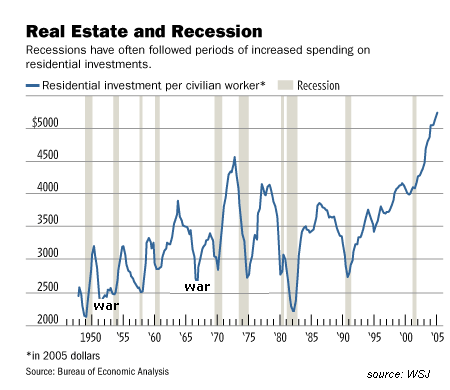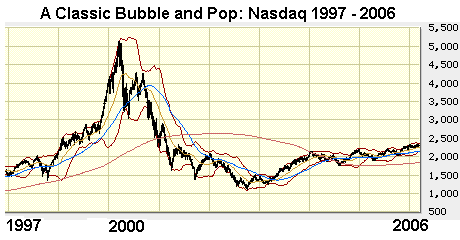

|
| weblog/wEssays | home | |
|
A Monster of a Housing Bubble (March 18, 2006) 
Take a look at this chart and tell me there's no housing bubble, and that real estate can keep on rising indefinitely. What the chart reveals is that over-investment in housing (as measured by investment per worker) is inevitably followed by a recession. The two exceptions which prove the rule were the Korean War and the Vietnam War, which goosed the GDP by 15% and 10% respectively, pulling the economy out of the recession which would have otherwise taken the nation by the throat. The cost of that deficit spending on both "guns and butter" in the late 60s and early 70s? A structural inflation which gutted the bond and stock markets for a decade. "This time it's different," we're told, because China's manufacturing costs are so low, inflation has been banished. "This time it's different;" hmm, isn't that what the housing Bulls are saying as well? Isn't that what the tech analysts were saying in January 2000, just before the dot-com bubble burst in March 2000? The glaringly obvious point is that the present level of over-investment is unprecedented, suggesting that the ensuing recession will be deeper and longer than previous over-investment/recession cycles. It's worth noting that the last "real" recession--that is, one that lasted more than a few months--occurred 25 years ago. That's an awfully long run of expansion. 
The chart's upward trajectory since 1990 has a eerie, if not downright frightening, resemblance to the parabolic rise of the NASDAQ stock market 1997-2000. As we all know, the NASDAQ subsequently plummeted 80%. Six years after the bubble's peak, the Nasdaq has only recovered 45% of its bubble valuation. That couldn't happen to real estate, the yammering industry Bulls yelp; maybe so, but what about a 40% drop? Check back in 2010 and let's see where valuations are then. copyright © 2006 Charles Hugh Smith. All rights reserved in all media. I would be honored if you linked this wEssay to your site, or printed a copy for your own use. |
||
| weblog/wEssays | home |